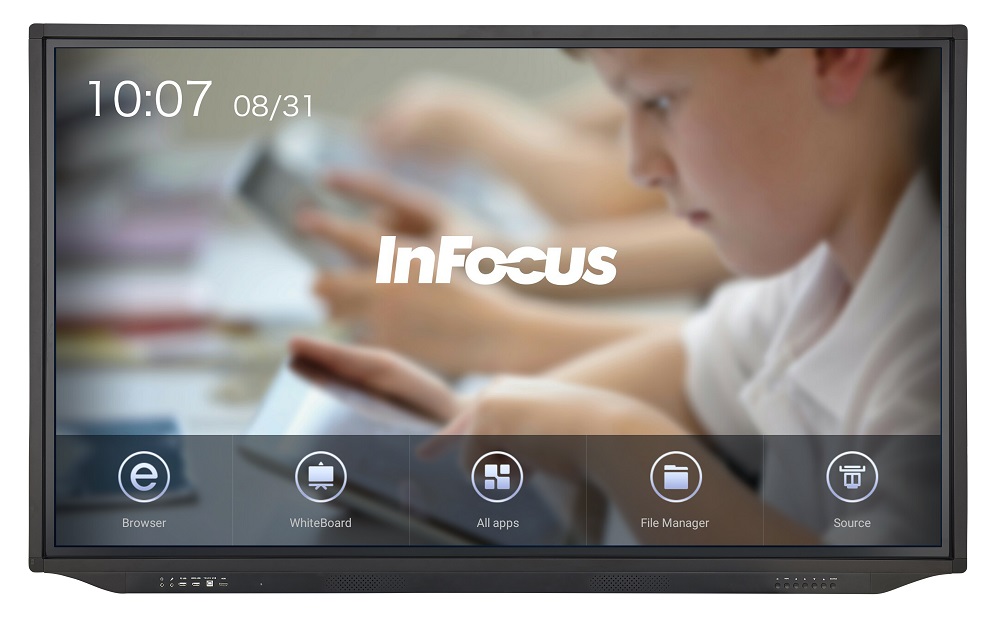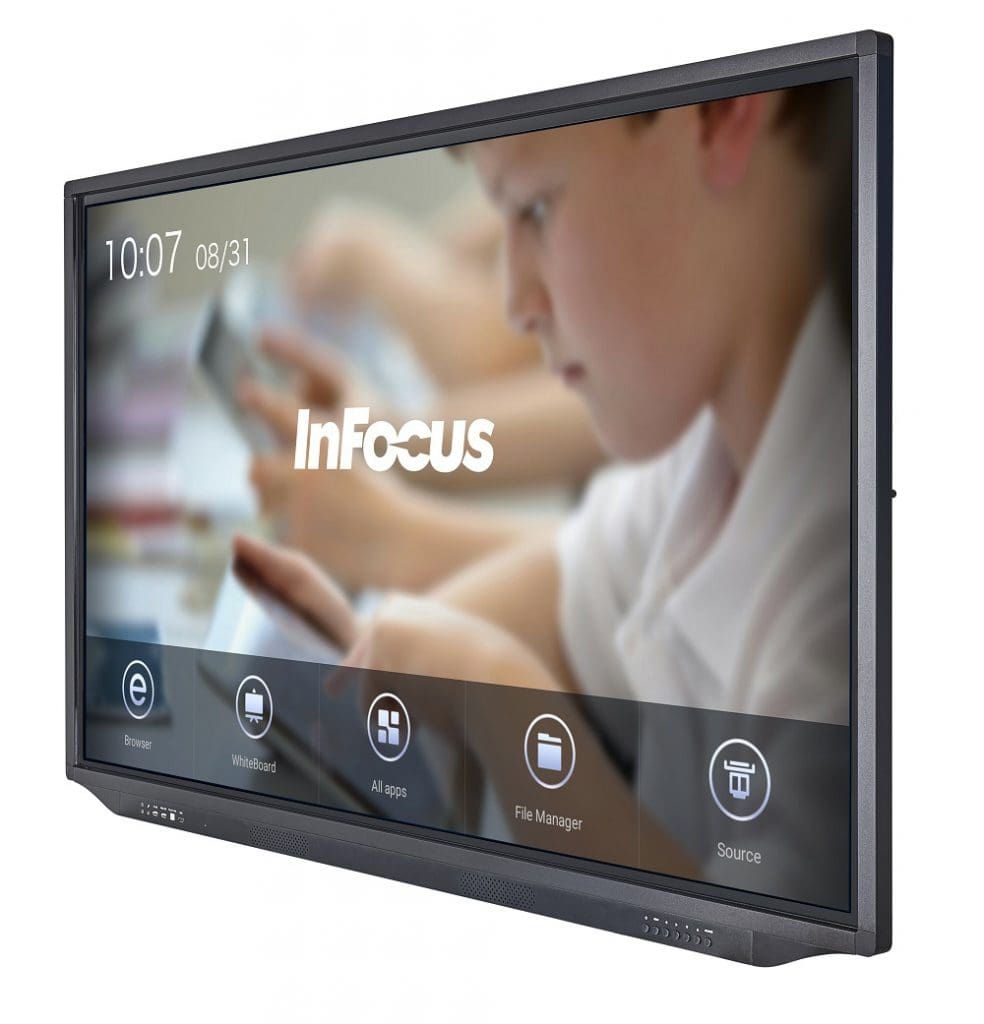Dynamic lesson plans, customized curriculums and compelling content are top reasons why classrooms at all levels – from K-12 to higher ed – are deploying digital technology. Yet as with any technology, there are pain points. Commercial Integrator recently had a conversation with Glenn Jystad, director of product marketing at InFocus to discuss how the company’s InFocus JTouch line of touch panels can address the most pressing pain points head on.
Touch Panel Performance: Speed over Quantity
Until recently, the concept of touch panel performance revolved around the number of touch points, with conventional wisdom positing that two touch points were not enough. To enhance touch performance and thus the teacher experience, the more touch points the better – why have two touch points when you could have 10, 20 or 30 touch points?
“The less a teacher is distracted by or has to think about how to draw on a screen, the more the teacher can focus on the task at hand,” says InFocus’s Glenn Jystad.
As Jystad sees it, that argument doesn’t hold up. When it comes to touch performance, “what matters is how natural the experience is,” he says. “The less a teacher is distracted by or has to think about how to draw on a screen, the more the teacher can focus on the task at hand.” That focus is directly correlated to how much a teacher enjoys using a touch panel. And while enjoyment is subjective, speed is a major factor. Even a brief delay in getting a response after touching the screen can be a distraction. Such delays – measured in milliseconds – are subtle, yet a teacher will perceive the difference between a slower system and a fast one. Indeed, teachers have shifted the debate on performance to focus on the the overall speed of the touch screen.
The highly responsive systems on the market tended to be cost prohibitive for the mainstream, says Jystad. Fast response at an affordable price will be a feature of the upcoming JTouch platform. “We’ll be offering tier 1 touch – the kind that feels instantaneous – in a cost-effective platform,” Jystad says.
Managing the Local Class Network
Another sticking point: controlling student access to the internet. Students today have grown up with the internet, and they will peruse it unfettered if allowed. In the classroom, giving students free reign is an invitation for disciplinary issues between students and teachers.
By the same token, there is great value in engaging kids with the content available on the internet. Thus, in the classroom there must be capabilities where the teacher can present rich, meaningful content that engages the students via participatory actions. When it comes to content presented in the classroom, students, says Jystad “may want to comment on it, vote, share their own work or respond.”
Striking a balance requires that all devices are connected – whether Chromebooks, iPads or personal student device – on the same network as the touch panel. Yet it is the touch panel that is accessing the internet – hence the challenge of connecting students to the touch panel without access to the internet. This is typically accomplished by setting up two networks at the same time – a wired network for the touch panel, and a local classroom wifi network for the students.
There is one potential hiccup to this setup. “The touch panels running Android are simpler, and Android has not supported talking to two different networks at the same time,” says Jystad. In response, “we are bringing out a platform that will allow Android systems to connect to both a wired and a wireless network and to isolate the applications so that students only communicate on the wireless network.” Students’ devices automatically connect to the wireless network in the classroom, which in turn connects to the touch panel on the wired network. Students can fully participate in the lesson easily and safely – interacting with internet-based content without accessing the internet itself. With the touch panel serving as a bridge between the safety of the wireless network and the internet-rich wired network, JTouch solutions provide reassurance for the teachers and engagement opportunities for students.
Keeping Power Consumption in Check
As touch panels proliferate, effectively managing power consumption is no small feat. While the difference in power consumption between a touch panel that is switched off and one that is in sleep mode is minimal, multiplying a single device by thousands can add up to hundreds of thousands of dollars per year in energy costs.
JTouch allows educational customers to remotely control the power status of touch panels. Administrators can identify all the displays and manage them separately or in groups.
Many school districts have responded by having staff members physically walk around at the end of every day to switch off touch panels in every classroom. While this is an effective strategy, it is hardly efficient or cost-effective.
JTouch allows educational customers to remotely control the power status of touch panels. Administrators can identify all the displays and manage them separately or in groups. Need to turn off some displays Monday through Friday at 5 p.m., and turn on others every Saturday at 9 a.m.?
This can be done via an automated schedule. By turning touch panels off when not in use, power consumption is effectively reduced to zero – potentially saving educational institutions significant amounts of money. “The opportunity to save money in a completely automated way is compelling to a large school district that has limited and fixed budgets,” says Jystad.
Relevant Content with the Power to Customize
With powerful touch panels and the full expanse of the internet at their disposal, teachers have more opportunities to present more content than ever before. The sheer volume of information can be problematic, as teachers still must devise lesson plans that are both compelling to students and relevant to the demands of the curriculum.
JTouch has partnered with independent software company Qwizdom to provide teachers with specialized tools for creating lesson plans and engaging students. Using the JTouch touch panel in conjunction with Qwizdom software, teachers can present content and dynamically control who has access to interact with that content on the screen. For their part, students can annotate the content on the classroom screen, review the material and share the information from their own device.
When it comes to creating a curriculum, JTouch also includes Qwizdom’s Oktopus software for generating digital curriculum and collaborating. Suppose a teacher wants to cover a unit on fractions; with Oktopus, the teacher can break the lesson into 20-to-30 steps depicted in different screens. The teacher can introduce concepts incrementally, and interact with the content dynamically, instructing the students in an engaging way. In addition, access to Oktopus includes a subscription to thousands of classes created by teachers that are specially designed for the assessment tests used throughout school districts. When teachers sign up for Oktopus, they provide information related to the state, school district, grade level and subject matter. In this way, the Oktopus subscription ensures the delivery of highly relevant content that is directly related to mandated assessments.
As a result, says Jystad, “teaching is hyper-customized and optimized for any school’s objectives.”











